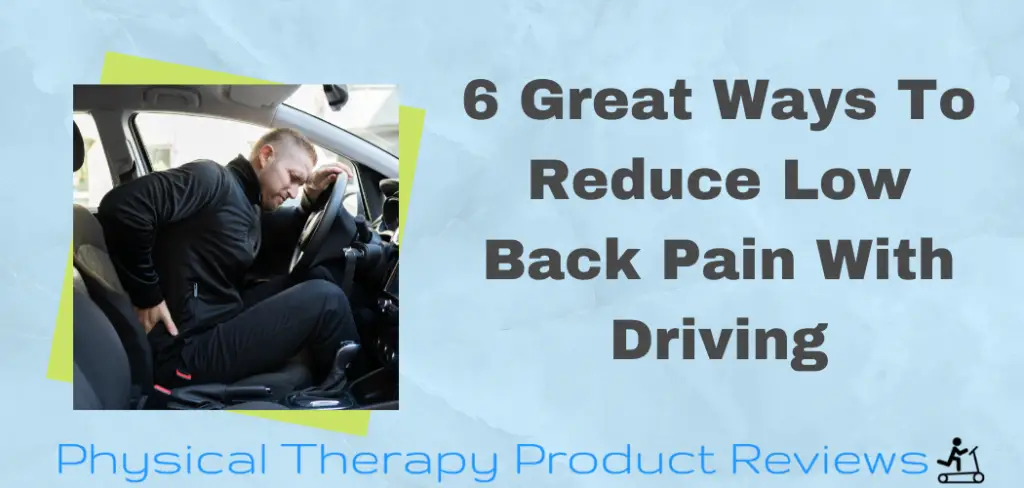Low back pain is one of the most common orthopedic complaints and reasons for visiting the doctor. Nearly 4 out of 5 adults will experience low back pain at some point. It’s estimated that low back and neck pain combined cost nearly 135 billion dollars each year.
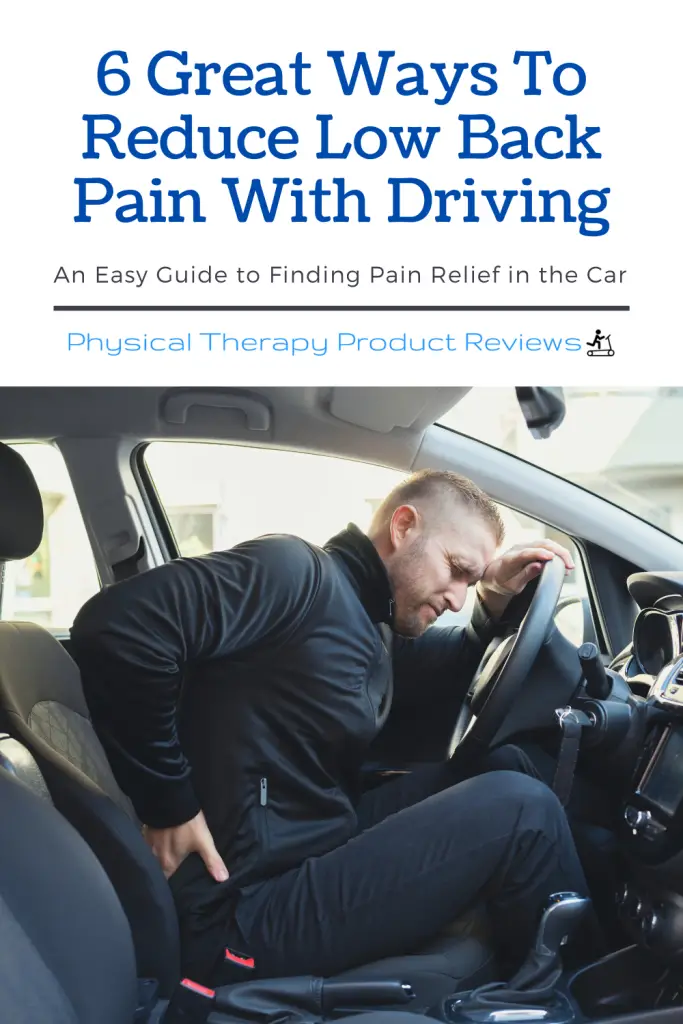
One of the most common aggravating activities for someone with low back pain is driving or riding in a car. Whether you’re commuting for work or driving professionally, it can affect anyone. Nearly 65% of all professional truck drivers reported chronic low back pain.
Riding in the car can be a tough activity on the spine. It puts the body through experiences that it is not originally designed to withstand.
Think our hunter-gatherer ancestors ever thought they would sit for hours speeding around at 60 miles per hour?
Riding in the car includes sudden acceleration, deceleration, changes of direction, and remaining in a flexed position for long periods of time. Not exactly activities our spine was designed to withstand repeatedly.
In this blog post, we’ll review the causes of back pain while driving, spinal conditions that commonly are irritated in the car, and tips to help reduce pain while riding or driving your car.
Why Riding in the Car Causes Back Pain
There are many different causes of low back pain that are worse when riding in the car. Very rarely does the car actually cause new back pain unless you are in a motor vehicle accident. Instead, back pain is almost always due to a previous injury that is exacerbated by one of three main issues:
- The position of the car seat and the resulting posture of the spine
- The amount of time sitting in the same position
- Finally, the vibration from the car and road interaction irritates structures
Lumbar Disk Injuries
One of the most common injuries irritated by driving is a lumbar disc injury. This can include a herniated disc, bulging disc, or degenerative disc disease. The discs act as shock absorbers in between the vertebrae of your spine. They have a tough exterior and a gel-like substance in the center.
Disc herniations happen when the gel-like substance leaks out of the disc due to a tear in the exterior. This can cause back pain and leg pain (sciatica). Bulging discs are very similar, but the gel-like substance does not leak out of the disc. Both conditions can be aggravated by sitting for long periods of time, as well as the vibration from driving.
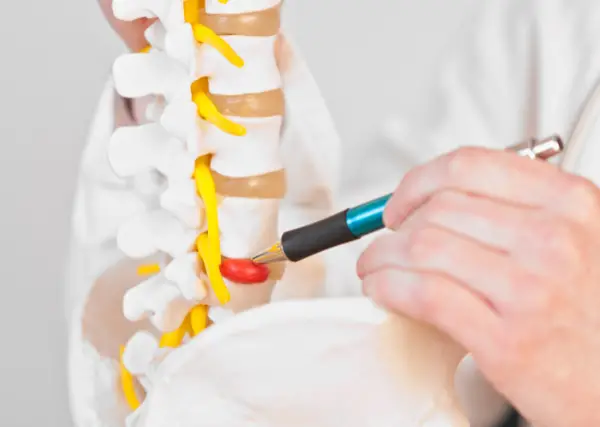
Degenerative disc disease is when the discs start to break down due to age or injury. This can lead to back pain and stiffness. Degenerative disc disease is often aggravated by sitting, as it’s difficult for the discs to get the nutrients they need when a person is inactive.
Lumbar Spinal Stenosis
Lumbar spinal stenosis is a condition that causes the spinal canal to narrow, which can lead to back pain and leg pain. This narrowing happens due to the disks in the spine degenerating over time. In addition, arthritis in the vertebrae also contributes to the narrowing through bony changes.
The disks start to bulge and take up more space in the spinal column, which puts pressure on the spinal cord and nerves. This pressure can cause back pain, numbness, tingling, and weakness in the legs.
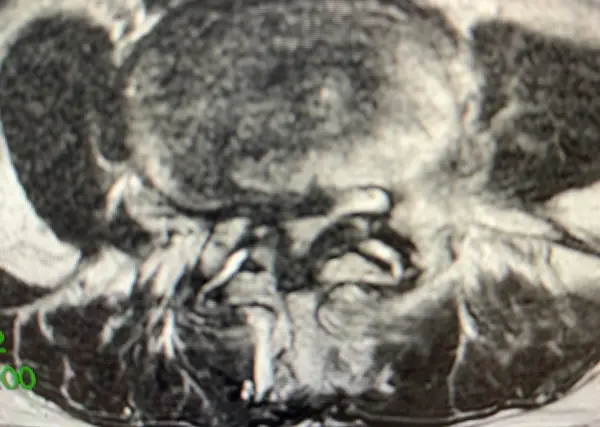
Lumbar spinal stenosis is often aggravated by sitting for long periods of time. This is because the disks have more pressure posteriorly when a person is sitting as opposed to other positions, such as standing and lying down.
Lumbar Facet Injuries
The facet joints are found on the back of each vertebra and act as hinges to allow movement in the spine. There are two facet joints at each level of the spine. Facet injuries can lead to back pain, especially with activities that load the spine, such as sitting.

Facet injuries can be caused by acute trauma, degeneration, or arthritis. Acute trauma can happen from a car accident or other injuries that put pressure on the spine. Degenerative changes to the facet joints can occur due to age, while arthritis is the inflammation of the facet joints.
All of these conditions can be aggravated by sitting for long periods of time as it places prolonged pressure on the facet joints. The vibration from driving can also make the pain worse.
Osteoarthritis: Wear and Tear Changes
Osteoarthritis is the most common type of arthritis and is caused by the wear and tear changes that happen to the joints over time. This can lead to back pain, stiffness, and loss of range of motion.
For people with osteoarthritis, sitting for long periods of time can be difficult as it puts pressure on the joints. Wear and tear are normal as we age. It just depends on how much has occurred and at what locations.
When more wear and tear occurs in certain spots of the spine, it can cause a sensitivity to position, such as driving. Getting that area calmed down and less irritated through exercises and physical activity is essential to driving with less pain.
Car Vibration May be the Ultimate Cause of Back Pain
The vibration from the car and road interaction is a guilty culprit in causing increased back pain. Take a spine and place is a flexed position, and then shake it around. Ok maybe, that’s a bit too dramatic, but the vibration of the moving vehicle is consistently demonstrating to be troublesome for back pain. This is because the vibration can irritate structures that already have sensitivity due to previous injury or age changes.
There have been numerous studies that demonstrate constant vibration on the spine can have a negative effect on pain levels.
Too much vibration from the car for too long can cause more back pain
In this study, using a removable backrest reduced EMG activity of the low back muscles by 28%. The backrest and other types of ergonomic devices appear to dampen the amount and frequency of vibration on the spine and thus result in less pain and better tolerance to driving.
Professional truck drivers have a 10-25% greater incidence of low back pain when compared to other populations. This increase is multifactorial with increased sitting time, obesity, and lack of healthy food options with life on the road. However, the consistent vibration of the vehicle also places a role in that increased percentage.
Risk Factors for Having Low Back Pain with Driving
There are many possible causes of low back pain while driving. It may be caused by a specific injury, such as a muscle strain or disc problem. Or, it could be the result of sitting in an awkward position for a long period of time. Additionally, health conditions such as arthritis and degenerative disc disease can lead to pain and discomfort while driving.
In many cases, the exact cause of low back pain may be unknown with further medical imaging such as an MRI. However, some risk factors may increase your chances of developing this type of pain. These include:
- Poor posture
- Obesity
- weakness and Deconditioning
- Sitting for prolonged periods of time
- Prior back injuries
- Pregnancy
- Lifestyle issues such as smoking/diabetes/sedentary lifestyle
If you are experiencing low back pain while driving, there are some things you can do to find relief. These include:
- Adjusting your seat position
- Try a removable back support or seat cushion
- Taking frequent breaks
- Practicing good posture
- Exercising regularly
- Strengthening and stretching exercises
Here are 6 helpful tips to decrease low back pain with driving
Adjust the Seat Height and Angle For Spinal Comfort
Sitting in a less-than-ideal position is the surest way to ruin a good movie, book, or conversation. You fidget, squirm, and can’t wait to stand up and stretch your legs. That’s why it’s important to adjust your seat height and angle before settling in for a long session of driving.
Most vehicles have seats that adjust in many different options allowing you to find the optimal position.
The ideal seat height should allow your feet to rest flat on the floor, with your knees bent at a 90-degree angle. As for the angle, it’s generally best to sit upright or recline slightly. This allows you to maintain good posture and avoid strain on your neck and back. The lumbar support of the chair should be adjusted to provide support and cushion against the arch of the back.
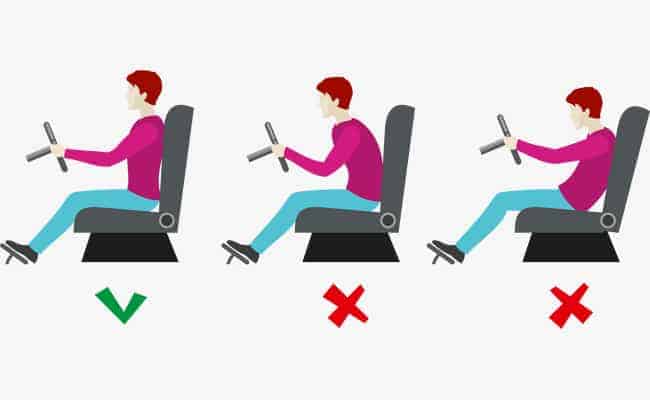
The seat angle should keep your knees in line with or lower than your hips. The higher your knees are above your hips, the more rounded your spine will be with driving.
You can adjust the headrest forward or backward to support your neck and take the strain off the rest of the spine.
The most common issues that we see in the clinic are the angle of the seat being too great forward or backward and the bucket of the seat angle being too great, causing the knees to be above the hips and causing the back to round, which it won’t like for long periods of time.
So next time you’re getting ready to settle in for a long road trip or car ride, take a few minutes to adjust your seat for maximum comfort. Your body will thank you for it.
Use a Lumbar Support to Keep your Spine Supported
As anyone who has ever suffered from back pain knows, even the simplest tasks can become agony. Even something simple as driving 5 minutes to the grocery store. Fortunately, there are a number of things that you can do to ease your discomfort.
One of the most effective tips is to use an external removable lumbar support. By keeping your spine in alignment and supported, a lumbar support can help to take the strain off of your muscles and joints.

The lumbar support works in two ways. First, by supporting the natural curve of the spine, it changes the angle of the spine sitting in the car seat. This changes where the pressure and forces of gravity are centered on the spine and place those forces in a more comfortable part of the spine.
Secondly, the little extra bit of support added to the joints and muscles can go a long way. The external support can reduce strain on the structures of the spine by a large order reducing pain in the joints and reducing pressure on the nerves.
There are a few different types of lumbar supports on the market. We first recommend rolling up a towel and placing it behind the back while driving. This is an inexpensive way to try more lumbar support.
If that works some but is not great, then you can order a lumbar roll, a soft support that attaches to your seat. The soft roll helps support the natural curve of the spine.
The other type of lumbar support is more form-fitting to the back and adds more support. This mesh seat insert supports the curve of the spine and the sides of the back with a naturally forming mesh. This is more supportive but also bulkier when getting into the car.
The best part about both supports is that they are easy to install, hook to your seat, and can be easily removed. Once installed, you won’t have to mess with them and will be good to go for further trips in the car from there on out.
Take Breaks Every Hour to stretch and Move Around
Let’s face it, sitting around all day is just not natural. Our bodies are meant to move, and when we don’t get enough movement, we can start to feel stiff and sluggish. That’s why it’s important to take breaks throughout the drive to stretch and move around.
Not only will this help to keep your muscles from getting too tight, but it will also boost your energy levels and help you to stay focused. When we sit for long periods of time in the car, critical structures in the spine don’t get as much blood supply as they need. This adds to the stiffness, and achiness one feels after driving for too long.
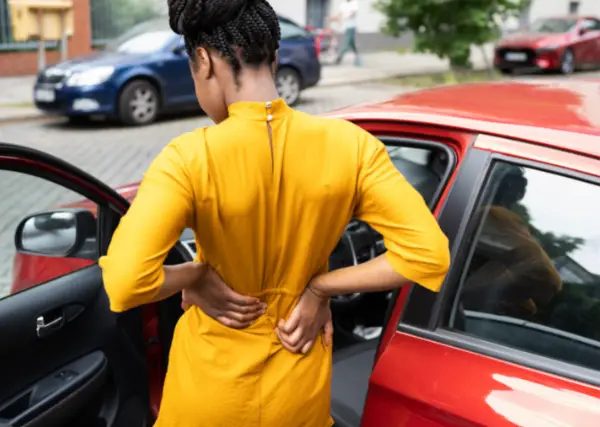
By sitting in one position for too long, the pressure is maintained on the same spots of the spine for the entirety of the drive. The structures of our backs just aren’t meant to maintain pressure in the same position for hours. This is part of the reason you feel achy. Too much time under constant pressure in the same position.
The easy part is that this is easy to fix. Stop at a rest stop and walk for a few minutes. Do simple low back stretches such as a hamstring or a figure 4 hip stretch. The simple changes in pressure will go a long way in reducing back pain.
Next time you start feeling sluggish, take a break and give your body a little movement. You’ll be glad you did.
Use a Hot Pack for Long Car Rides
If you’re going on a long car ride, it’s always a good idea to bring a hot pack with you. You never know when you might need it.
A hot pack can help decrease muscle tension and can also provide a little support to the spine, similar to the lumbar supports that we mentioned above. The hot pack also provides an increase in blood flow which helps speed up healing and prevents the spine from stiffening up as fast in the car.
There are two options for using heat while in the car. The first is using a microwaveable hot pack for as long as it can stay hot. The other option, which we prefer, is to use a heated blanket that plugs into the car. The heated blanket can stay warm longer; you can roll it up to provide the proper support. Plus, a heated blanket is perfect to have for colder car rides for the rest of the family.
Plus, it’s always nice to have a little warmth on hand in case you need it.
Try Sitting on a Support Pillow in the Car
If you find yourself getting get back pain while driving, it might help to sit on a specialized pillow made to ease back pain.
This will raise your hips slightly and take some of the pressure off of your back. Additionally, it can help to keep your spine in alignment and reduce the risk of increased pressure through areas that may already have wear and tear.
The other important aspect of using a support pillow is that it helps damper the vibration of the car. As mentioned above, the vibration of the moving car can easily aggravate joints and nerves that are already a little angry. The support pillow helps damper that vibration and thus reducing nerve irritation on long car rides
So if you’re looking for a way to make long car rides more comfortable, give this a try. You might be surprised at how much difference it makes!
Keep Good Posture While Your Driving, Even On Long Trips
It’s easy to get lazy when we’re driving. We sit for long periods of time in the same position and often let our posture slide. But good posture is important, even when we’re driving.
Maintaining good posture helps to keep our spines in alignment and takes the pressure off of areas that may be susceptible to pain. Additionally, good posture helps to keep the muscles around our spine strong and healthy.
It can be difficult to maintain good posture for long periods of time, but it’s important to try. If you find yourself getting tired, take a break and stretch your back. And when you get back in the car, try to sit up a little straighter. It might not seem like much, but it can make a big difference in your back pain.
Most people start to lean to one side with the opposite hand on the steering wheel. Leaning to one side for too long places asymmetrical pressure on the spine. While not dangerous to do for short periods of time, over long stretches of time, it can cause issues and increase pain.
If you keep your hands at 9 and 3 on the steering wheel, you almost have to have good posture without leaning to one side.
Conclusion
By following these simple tips, you can make your next road trip much more comfortable – and safe!
So the next time you’re getting ready to hit the open road, be sure to adjust your seat, keep your hands at 9 and 3 for proper posture, use a lumbar support, have a lumbar pillow ready to add some cushion, take breaks often, and use a hot pack on long rides.
Once you have everything in the car and in place ready for you, there is a minimal hassle. It may sound like a lot, but now you have options. You no longer have to dread getting into the car for fear of back pain.
You (and your back) will thank us later!
Disclaimer: The information provided in this post is for educational purposes only. This is not a substitute for a medical appointment. Please refer to your physician before starting any exercise program.
